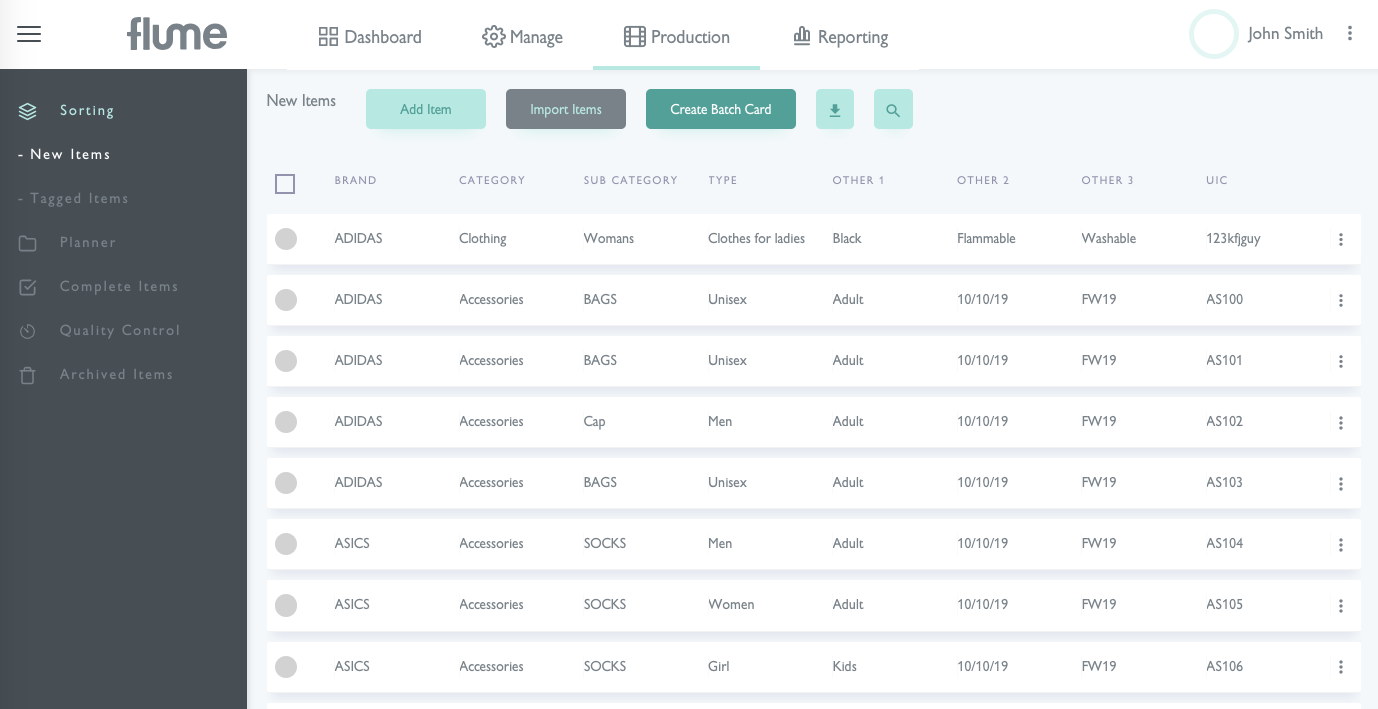
Let’s have a look at Flume in a bit more detail.
Setting up your operation thoroughly and carefully up front will allow you to build a strong foundation and create a highly efficient workflow.
This will allow the system to work intuitively for you, substantially reducing ongoing manual input.
When you first get started with Flume, you’ll set up all of the Services (the things you do), Spaces (where you do them) and Team (who does them) within your production department.
After adding each Team Member you will assign them a specific Role and Permission level. This helps to create the all-important workflows behind the scenes and permissions dictate what access users will have in Flume. Keeping things safe and secure.
Next you will create the Services being carried out within your operation. This is completely customisable, so whether you are in e-commerce and carry out Mannequin Photography, Table Top Photography, Content Writing and Retouching you can name your services as you please. Just as, if you are managing the workflows in a commercial kitchen for example you might have Food/Kitchen Service Preparation and Kitchen Cleaning as two primary services. The Icon library forces you to assign an icon of your choice to each Service, making things simpler and more visual throughout the system.
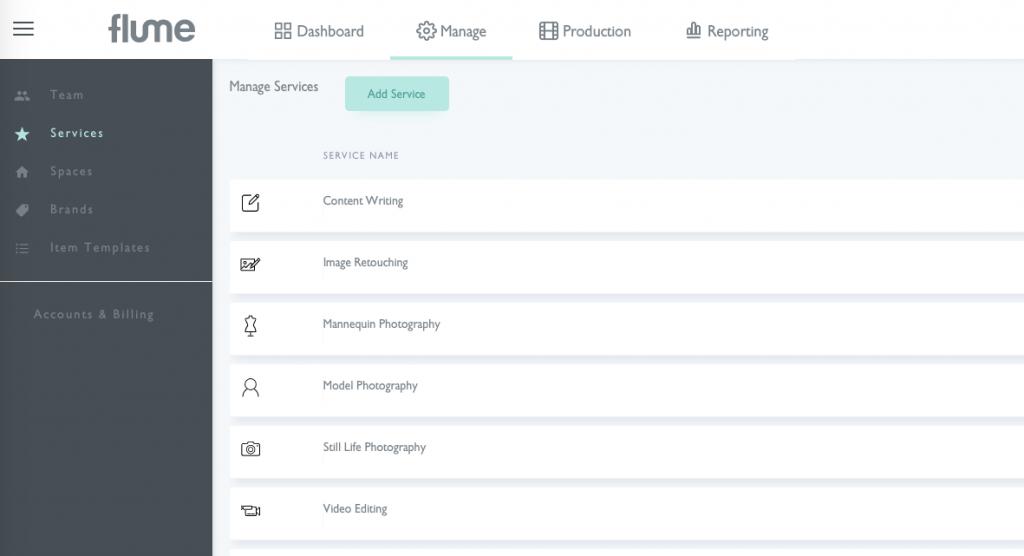
You then create the Spaces where these services will be carried out. They can be virtual or physical spaces and again you can name them whatever you like so no need to conform to any generic names that don’t work for your business. When we talk about Physical space, we mean Photography might be carried out in a Studio which is a physical space. However a Retoucher might carry out his work at a desk on a computer, so the Space could be called Retoucher Desk 1 for example, basically it doesn’t need to be a room with four walls. You will assign a colour to each Space that you create, again to make things more visual and user friendly within the system.

Next you would add your Brands and Sub Brands into Flume. You might just be a stand alone brand but you also might have a business that produces for multiple brands and sub brands. It’s important that this information is captured and stored so that the system can work more dynamically for you and again reduce manual intervention.
When it comes to your data we wanted the user to feel that they are not restricted to having to fit within rigid parameters but that they are in control and can set their department up in a way that feels good to them. We created 12 item templates to choose from so that the user could find one that most suits their operation. The template then helps them to easily import product data into the system and displays it in a way that is easy for them to view and understand.
One of the most key features of Flume is the Batch Card.
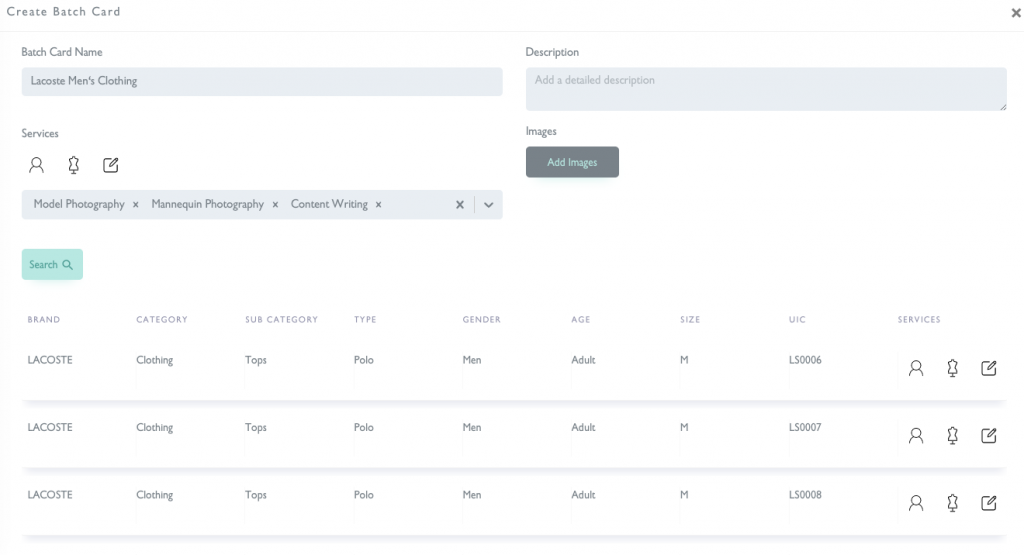
Once you have imported your product data into the system you can group your products, as you wish, depending on how you want to manage the department or individual team member’s workloads. The grouping or Batch Card concept allows for substantially increased efficiency. A user could group products based on Priority, based on which services they need, based on what brand or category they are. The options are endless and again puts the user in control. There could be 1 item in a Batch Card or hundreds of items.
We believe the most pivotal and arguably the most key design feature within Flume is the Planner.
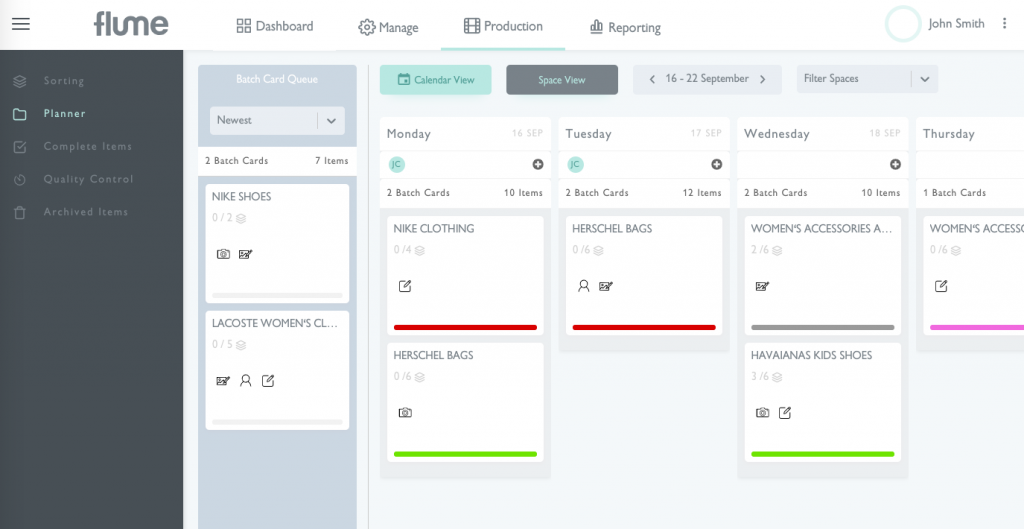
Planning is at the core of any successful Production Department yet often Planning is absent from existing systems. Our intuitive Planner allows for full visibility of the workload within the production operation for those who need it but also provides users with specific workloads to only see what they need to carry out, reducing overwhelm and increasing productivity.
Flume allows easy toggling between specific spaces or individual users to view each workload.
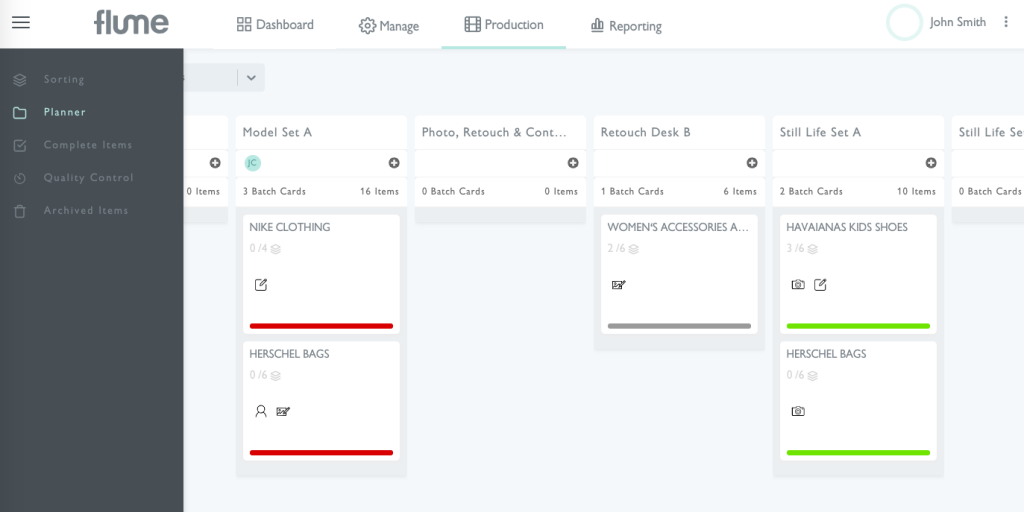
Within any Production environment, there are multiple workflows which all rely on each other to function at an optimum level to provide an efficient department. However, some workflows need to be done simultaneously and others are reliant on another process to have been completed in order to begin. With so many moving parts, Flume has been carefully designed to handle non-linear workflows seamlessly. This gives team members and managers clear visibility of their workload and empowers them to start working on their tasks without delay.
Not only does Flume manage and track each item through the full Production operation but each item becomes a rich piece of data in its own right.
There are customisable Headers and Content Blocks for the Content Writer to add rich product content for each item. Content that is common across multiple items can be written once and duplicated in bulk across all selected items to save time and reduce error.
Images can also be uploaded individually per item or in large batches of hundreds of images at a time. The images will automatically map to their relevant Item Code by their simple, industry standard naming convention. The image thumbnails uploaded provide the Content Writers with visual information so they can increase the quality of their content, the images are also crucial for Content Teams that might be in another geographical location where they would not come into contact with physical samples.
These thumbnails are also essential for Quality Control. We have designed a QC module which allows you to ensure full an final QC is carried out on each product which s is an integral part of the workflow.
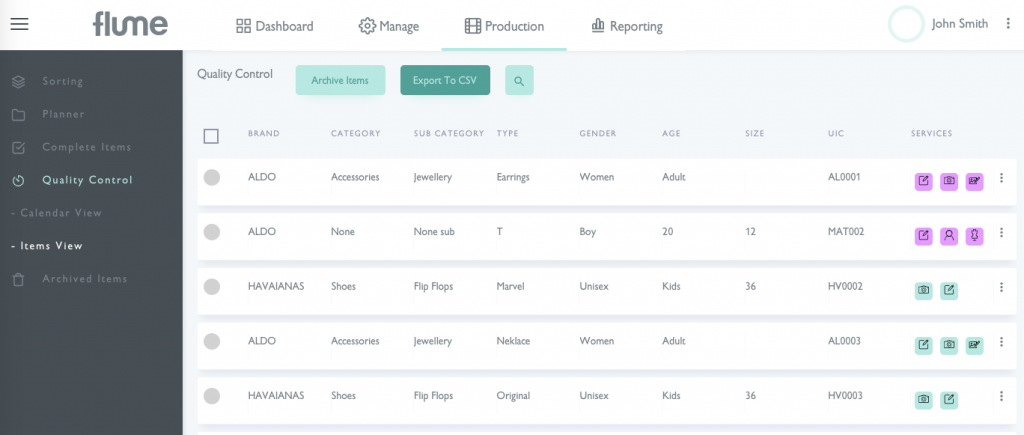
As soon as Items have had all their Services completed they will appear automatically in the QC module. Throughout Flume each item has a viewing window where the user can add or view images and content relating to that product.
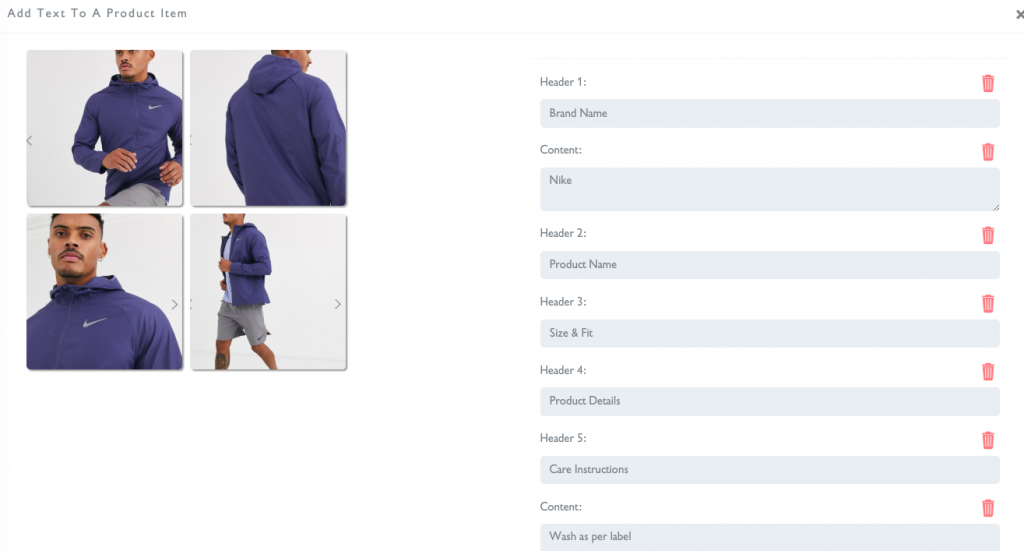
This viewing window is a key design feature for the QC Module as it allows the Quality controller to view all images and content at the same time. They can also see the team that has worked on the Items, allowing for performance accountability.
In the QC Module, items can be approved individually or in bulk. If an item needs to be rejected, for whatever reason, a simple tagging workflow is applied where the item receives a tag stating why it can not be approved automatically moves to the beginning of the workflow to be dealt with. The item can then be re-introduced into the relevant workflow to get it fixed and completed. This eliminates items getting lost or stuck in any workflows.
Flume provides high level reporting on workflow metrics as well as performance metrics. It offers up graphs which can be filtered to capture specific time frames and covers how many items are currently in the workflow, how many are waiting to enter the workflow and how many are in which stage of each workflow. The user can also see how healthy the operation is by looking at specific spaces and services and how efficiently each of them are running.
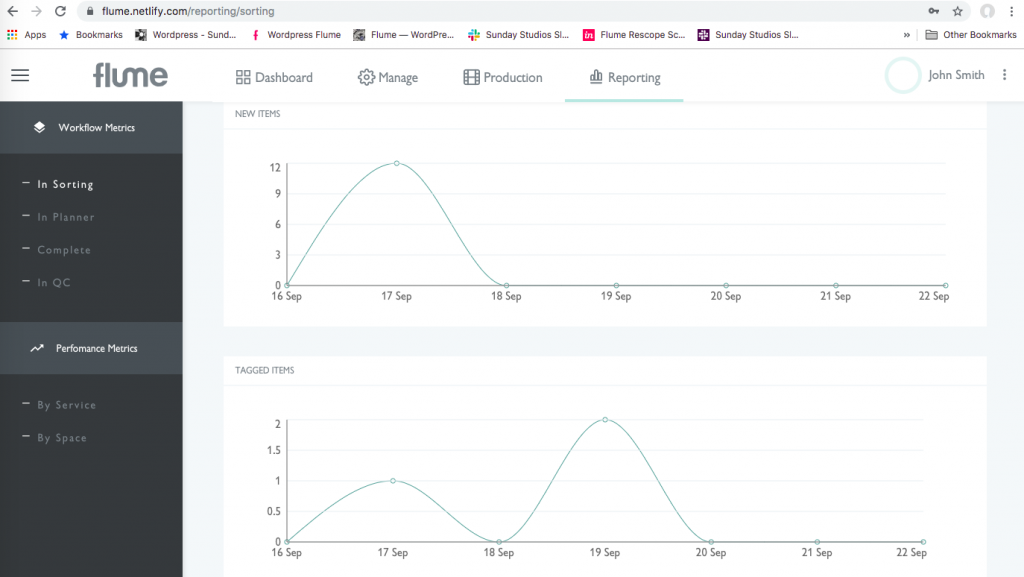
Flume also features a live dashboard that offers you clear, instant and live visibility on all key departmental metrics.
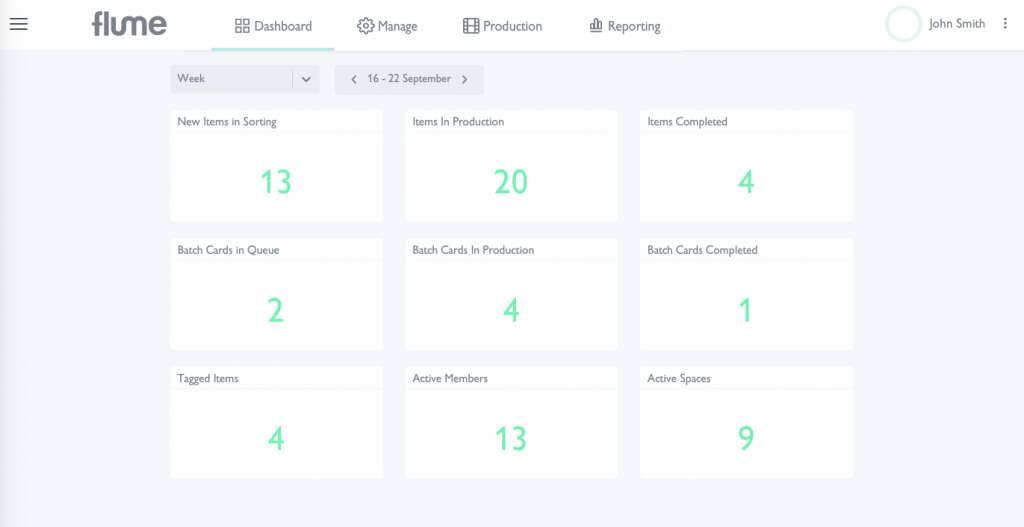
Flume is a secure cloud based software which provides complete flexibility and would be what we describe as a Plug & Play product. Flume recognises that each business and operation works with varied Industry standard programs and systems and doesn’t want to interfere with what is working. Flume just wants to make your complex Production workflow management as simple as possible!
Thanks for considering flume – we look forward to working with you. Sign up for a 30 day trial to see if Flume is right for you!
